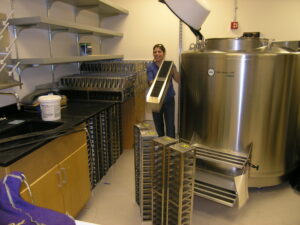Tissue Collection
The MVZ tissue collection and associated Evolutionary Genetics Laboratory were established in 1973 with initial funding from the National Science Foundation. It now ranks as one of the largest such collections, housing over 120,000 tissue samples from over 14,500 fish, 34,000 amphibians, 17,000 reptiles, 18,000 birds, and 40,000 mammals. The majority of samples have voucher specimens that are housed either in the MVZ or in other institutions. Tissues are routinely preserved from specimens accessioned by the MVZ. Samples are stored either as frozen tissue in liquid nitrogen tanks or as non-frozen tissue in ethanol or buffer. In many cases, specimens are represented by multiple vials with the same or different storage methods.

Taxonomic and geographic representation of samples primarily reflects the research interests of MVZ faculty, research staff, and graduate students. Thus, the mammal tissue collection is especially strong for New World rodents and bats, the bird collection is dominated by New World passerines, and the herpetological holdings are strongest in New World and Old World salamanders, lizards, and snakes. Over the past few years, expeditions throughout the world (including Indonesia, Afghanistan and Madagascar) have resulted in significant acquisitions of new taxa. In addition, general salvage of specimens from various sources has and continues to provide a major source of new material.

Uses of the MVZ tissues range from phylogeographic and systematic studies to research in adaptation, conservation genomics, and epidemiological applications such as the tracking of hantavirus. In addition, DNA obtained from traditional specimen material (e.g., skin, hair, feathers, toe pads, bone) represents an increasingly important resource for genetic studies, especially those with a historical component (for example, the impact of malaria infection on Hawaiian birds).
In 2013, we upgraded our tissue collections’ facility to new liquid nitrogen tanks for all tissues and improved object tracking using barcodes on vials, containers and racks. Moving away from electricity-dependent ultra-cold freezers was motivated by our need to be more sustainable and be more resilient in case of power outages. This was possible with a grant from NSF (NSF DBI:BRC #0846349).
Tissue Requests
Unlike traditional specimens, tissue samples are eventually depleted with use. Requests for tissues from the MVZ collections must follow our loan policy to ensure that destructive sampling does not exhaust these limited resources. As with other loan policies, we emphasize the importance of proper acknowledgement of the MVZ collections in any publication that results from the use of its tissues (see guideline).
MVZ graduate students and postdoctoral researchers should submit the MVZ In-house Tissue Use Form, signed by their faculty advisor, to a Curator for approval.
